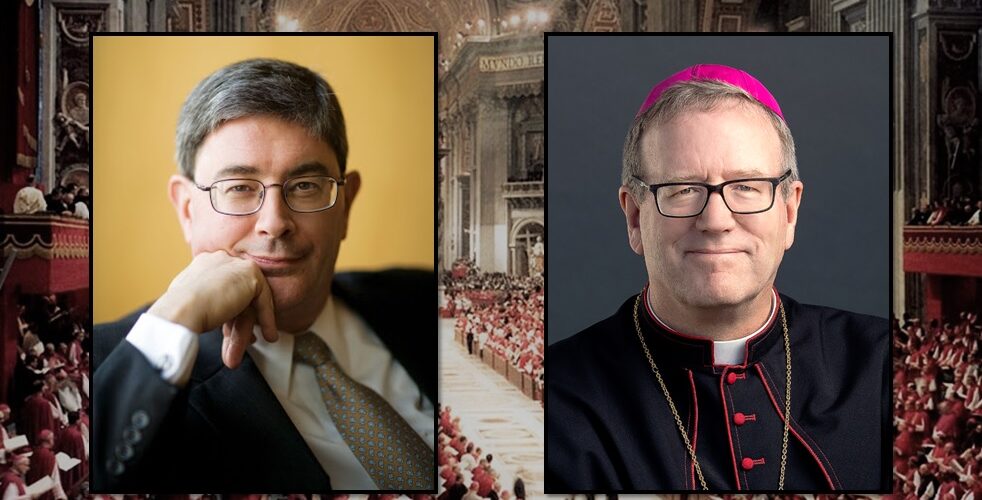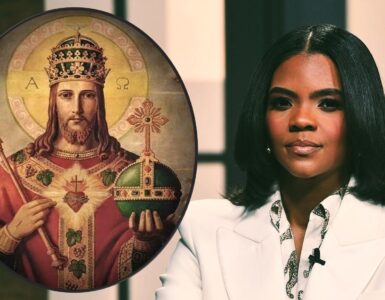The Empire Strikes Back (1980) is generally regarded as one of the better, if not the best, Star Wars films. If you haven’t seen it already, the plot involves Darth Vader and Emperor Palpatine (the “bad guys”) throwing down the hammer against the “rebel alliance,” a ragtag group of freedom fighters trying to bring justice to the galaxy, against all odds.
The various responses made by establishment Catholics in recent days to the blunt but undoubtedly true remarks made by Archbishop Carlo Maria Viganò about Vatican II mirror what played out in that movie.
The Knives Are Out
Up until now, Archbishop Viganò has largely been ignored by the power brokers who run what Archbishop Marcel Lefebvre originally referred to as “the Conciliar Church.” Catholic writers and media outlets have been content to dismiss him as a “conspiracy theorist” who touts absurd claims about homosexuality in the Church.
In recent days, His Excellency has received more attention than usual, undoubtedly because of President Trump’s tweet thanking him for his letter but also because of his increasingly stringent, nerve-striking assaults on the Second Vatican Council.
Predictably, conciliar authorities have leapt into action over the last two weeks (although Pope Francis has remained utterly silent) in order to prevent Catholics from thinking the Council was in any way discontinuous with the past, as Viganò suggests it was.
Neo-Cons Attack
Among the dutiful soldiers following the Deep Church’s marching orders is Americanist commentator George Weigel and Bishop Robert Barron of the Archdiocese of Los Angeles.
In a recent article for First Things, Weigel, who always seems to be stuck living in the 1980s for some reason, argues that both “ultra-traditionalist” and “progressive” Catholics get things wrong.
“To claim that Vatican II was a Council of rupture and reinvention is to say, in effect, that [John XXIII, Paul VI, and John Paul II] were either duplicitous, anti-conciliar reactionaries (the tacit indictment of the progressives) or material heretics (the tacit indictment from the far right-field bleachers),” he writes.
“Neither indictment has any merit, although the latter has recently gotten undeserved attention, thanks to ill-considered commentaries reverberating through the echo chambers of social media and the ultra-traditionalist blogosphere.”
Presumably, he’s speaking about Archbishop Viganò.
Interestingly enough, Bishop Barron has taken up almost the exact same argument. In a YouTube video, Barron marshals non sequitur after non sequitur in an embarrassing attempt to paint himself (and those who guided the Council) as the “firm middle ground” between those who flail about on the right and on the left.
“Others believe that the Church should turn backward and inward on itself,” he tweeted, without naming names. “But Vatican II avoids both extremes by emphasizing both doctrinal stability and a robust missionary zeal.”
Really? Was the Church before the 1960s doctrinally unstable and lazy? Did the Church of our grandparents not want a “Christ-centric” world?
It’s patently absurd to insinuate such things. Catholic Action was alive and well all throughout the world during the first half of the 20th century. Multiple pre-conciliar popes repeatedly called on the laity to convert the world to Christ. St. Pius X spoke about that in Il Fermo Proposito and Fin Dalla Prima Nostra. And Pope Pius XI affirmed those teachings in Non Abbiamo Bisogno.
Ultimately, the post-war new world order greatly feared the Catholic Church as it existed before the Council. No grand updating was ever needed. “It would be very wrong to imagine that [the pre-conciliar church] was something broken and in need of repair,” the late University of Notre Dame Professor Ralph McInerny once remarked.[1]
Empty Catch Phrases Won’t Cut It Anymore
Catholics today, especially the youth, aren’t buying what Barron and Weigel are selling. The “Vatican II Church” — a term that Bishop Thomas Tobin of Rhode Island used in a smear attempt against Archbishop Viganò last week — is a dying church. Not only has it been hemorrhaging vocations for decades, the so-called “New Evangelization” (how long are we going to hear that term for anyway? Another three decades?) has been an unmitigated disaster for the Faith. A tree is known by its fruits!
Fr. Joseph Clifford Fenton (1906-1969), an American priest who attended the Council, wrote in his diary in 1962 that, “from surface appearance it would seem that the Lord Christ is abandoning His Church…as far as I can see the Church is going to be very badly hurt by this council.” Undoubtedly, he was right.
What Really Happened at the Council?
Anyone who studies Vatican II from an objective, impartial point of view should realize that no matter what this bishop or that pope says about the Council (even if they are considered a “saint” by the Conciliar Church), Vatican II represents a profound break with what came before.
The council’s original preparatory schemas took years to compile. All were written in crystal clear, unambiguous, and wholly Catholic language. One of them discussed in great detail the subject of Mary being the “Mother of Men.” Another condemned Communism (read some of the original schemas here).
Yet all of the documents were thrown out within days of the Council’s opening. Why? Not because the Holy Ghost wanted them to be. Rather, because they weren’t ecumenical enough for the liberal Council Fathers, who used parliamentary maneuvers to impose their agenda and who invited the non-Catholic “observers” to help write the revised documents themselves.
The schemas were also cast aside because progressive clergy hated the way they affirmed Scholastic, anti-modernist theology.
“When we began our work, we found ourselves confronted with schemata that were very juridical in content and in tone,” Cardinal Leo Joseph Suenens of Belgium complained at the time.[2] Suenens later described Vatican II as the “1789 of the Church.”
“Much of what was in the schemata proposed for the considerations of the Fathers of the Council was juridical and academic in tone,” Cardinal Paul-Émile Léger of Canada remarked. “We could see that the schemata were not pastoral enough.”[3]
What His Eminence meant to say was that the schemata weren’t sufficiently liberal enough.
The new texts conjured up by the Council’s neo-modernist periti (some of whom just years before had been censured by Rome) included many sections that were intentionally ambiguous. Hidden “time bombs” were placed in the documents so that in the years following the council they could be used by liberal-minded clergy to implement novel practices. The documents were, simply put, never meant to be interpreted in a “traditional” manner.
It’s been said that where there is no hatred of heresy, there is no holiness. Question: did the Vatican II documents express hatred of heresy? Not at all. In fact, not only did the Council not issue one anathema, it “insisted very much more upon this pleasant side of man, rather than on his unpleasant one, “ Pope Paul VI said during his closing speech in 1965. “Its attitude was very much and deliberately optimistic.”
During a recent interview with journalist Phil Lawler, Archbishop Viganò said that at Vatican II the “perfectly orthodox preparatory schemas” were replaced with “a bundle of cleverly disguised errors behind long-winded and deliberately equivocal speeches.”
Vatican II was therefore a Revolution in the Church, one that deserves to be forgotten. “If a magisterial act raises serious and reasoned arguments that it may be lacking in doctrinal coherence with magisterial acts that have preceded it, it is evident that the condemnation of a single heterodox point in any case discredits the entire document,” he said.
Vatican “New”
Again, what the Council produced was not remotely in continuity with the past.
What Catholics were welcomed with in the years after were revised sacraments, a new Mass, a new liturgical calendar, new rules on fasting, new rules on marriages, new rules for declaring saints, a new theology, new prayers, a new catechism, a new Code of Canon Law, a new translation of the Bible, a new understanding of who actually comprises “the Church of Christ,” and new teachings on the Jews, Protestants, and on other non-Catholics.
There isn’t the faintest desire to carry on the Catholic religion as it existed before. Even Bishop Barron has tacitly admitted that. John Paul II had “zero interest in reviving pre-conciliar conservatism,” he once wrote.
Trying to apply a “hermeneutic of continuity” to such a situation is simply an impossible task. One drop of poison is enough to ruin the entire glass of water. Viganò is right to say Vatican II “should be forgotten ‘as such and en bloc’…where error reigns or even only worms its way in, there cannot be Charity.”
“Conservatives” Today are Actually Liberals
The dichotomy used by Weigel, Barron and others in order to paint “the progressive left” and “the ultra-traditionalist right” as two sides of the same coin is, on its face, a totally bogus comparison.
One way to think about what happened at the Council is to imagine the Church as if it were a train. Since the “Enlightenment” and the French Revolution, the church was barreling full steam ahead, condemning liberalism and modernism in the 19th and 20th centuries and calling on men to repent of their errors and come back to Christ during and after the Second World War.
At Vatican II, that all changed. The railroad switch was pulled in the opposite direction and the train veered to the left, deviating from the tracks it had been on for centuries onto a new set of poorly constructed ones. What used to be considered “liberal” before the Council became “conservative.” And what used to be considered “conservative” has since become “traditional.”
What Weigel and Barron fail to mention amid all their flowery language about “continuity” is the simple fact that the Council was a total victory for the radical, neo-modernist forces — and a slaughter of the conservatives. As Cardinal Joseph Ratzinger remarked in 1984, “The problem of the Council was to acquire the best expressed values of two centuries of ‘liberal’ culture…and purify them.”
Church historian Professor Roberto de Mattei has likewise pointed out that, “Liberal Catholics were defeated by the First Vatican Council but after a century, they became the protagonists and winners of Vatican Two.”
The Church Must “Go Back” to Tradition
By the grace of God, Archbishop Viganò has been blessed to realize that going back to the Council is not the answer. He’s even woken up some mainstream Catholic voices to the fact that embracing Tradition, tout court, is the only way forward.
“The Council was in fact a dishonest operation, a scam carried out against the faithful and the clergy,” Viganò said recently. “I do not find anything reprehensible in suggesting that we should forget Vatican II.”
Only when the current head of the Catholic Church rediscovers Tradition and confirms his brethren in the Faith (cf. Luke 22:32) will the nearly six-decades-long crisis afflicting the Mystical Body of Christ come to an end.
Until that happens, the Catholic Church will continue to lumber on, stumbling and staggering along the way while men like George Weigel and Bishop Robert Barron try to convince us that an event as radical and revolutionary as Vatican II was actually an instance of the Holy Ghost boldly leading the Church into the New Pentecost. May Our Lord, in His infinite mercy, spare us from such blind guides.
[1] Ralph M. McInerny, What Went Wrong with Vatican II: The Catholic Crisis Explained (Manchester, New Hampshire: Sophia Institute Press, 1998), pp. 7-8.
[2] Walter Abbot, Twelve Council Fathers, MacMillan, January 1, 1963
[3] Ibid.




